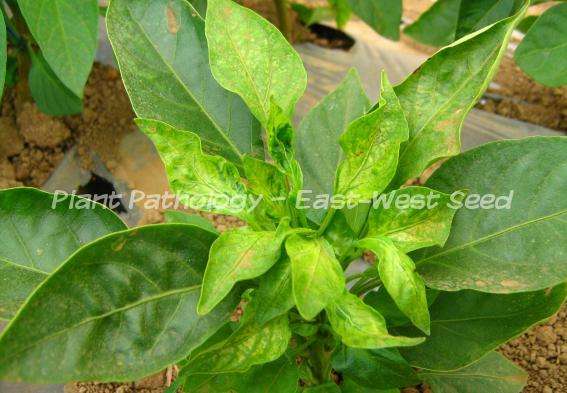Causal Agent:
Cucumovirus (Cucumber mosaic virus CMV)
| Characteristic Symptoms: | |
 |
Symptoms may vary depending on the virus strain, variety and plant age at infection. |
 |
Symptoms on young leaves are small green-yellow spots, which is initially slightly transparent, and progresses into yellow mosaic with distorted leaf blade, reduced leaf size and shoe-stringing. |
 |
Plants infected at very young age are usually stunted. |
 |
In some varieties, ring spots can be observed on the lower leaves and fruits are wrinkled or may show necrotic marks. |
| Transmission and Spread: | |
 |
The virus is transmitted in nature by more than 80 species of aphids, including Myzus persicae in a non-persistent manner (vector can acquire and transmit the virus after feeding for only one minute). |
 |
The virus has a very wide host range and may infect many crops including cucurbits, solanaceous and others. |
 |
The virus is not transmitted through pepper seed. |
 |
The virus can be transmitted mechanically but workers handling infected pepper plants do not readily transmit it since the virus is not as stable as TMV. |
| Management and Control: | |
 |
Use resistant varieties, if available.
|
 |
Use virus-free seeds and seedlings.
|
 |
Remove infected plants as early as virus symptoms are observed to prevent/minimize spread of the virus by aphids. |
 |
Remove weeds that serve as alternate hosts/virus reservoirs.
|
 |
Disinfect tools, farm implements with chlorine solution before moving from diseased areas to healthy areas.
|
 |
Control/minimize aphid population by using plastic mulch, yellow sticky traps and/or use of insecticides such as azadirachtin (neem), cartap hydrochloride (e.g. PadanⓇ, Barena 50 SP, Gemtrak®), acetamiprid (e.g. MospilanⓇ), acephate (e.g. AcetamⓇ, CompeteⓇ), chlorphenapyr (e.g. Kotetsu) or penthoate (e.g. PennantⓇ, VidexⓇ). and acephate (e.g. Compete®).
|
To view other diseases, click here.
Need more help? Ask the Doctor.






